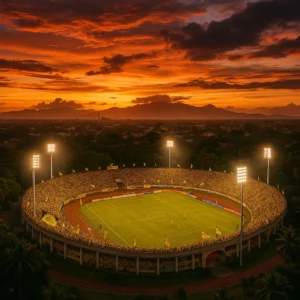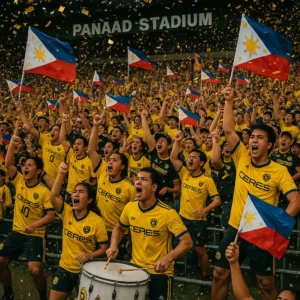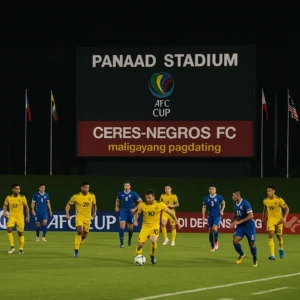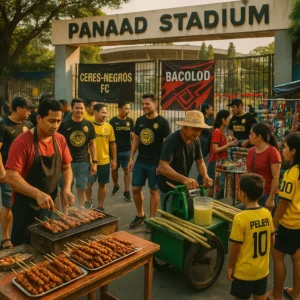Panaad Stadium in Bacolod City isn’t just a football venue — it was the heartbeat of Ceres-Negros FC’s golden era. From roaring home crowds to international triumphs, the club’s rise from local favorite to Southeast Asian powerhouse was deeply tied to the spirit of this stadium.

Let’s explore how Panaad became more than a home field — it became a symbol of Philippine football’s rebirth.
The First Dominant Season on Home Soil
When Ceres-Negros FC began competing in the United Football League (UFL) and later in the Philippines Football League (PFL), Panaad quickly transformed into a football fortress.
-
The club remained unbeaten at home for multiple seasons.
-
Panaad’s turf saw crucial victories against both local rivals and international contenders.
-
Fans from across Negros Occidental packed the stands, creating a unique Visayan football culture.
This solidified the stadium’s status as the home of champions in Philippine football.
Hosting International Glory in the AFC Cup

One of the most defining achievements came when Ceres-Negros FC hosted matches for the AFC Cup, Asia’s prestigious club competition.
-
The club defeated Vietnam’s Hanoi FC and Malaysia’s Felda United at Panaad.
-
These games drew record-breaking crowds in Bacolod.
-
Panaad became the face of Philippine football on the Asian stage.
This era boosted the global visibility of Philippine clubs in international competitions.
More context about memorable matches
Uniting Bacolod Through Football Fandom
The stadium stands weren’t just filled — they were alive.
-
Drums, chants, and coordinated crowd displays became the norm.
-
Local fans dubbed themselves the “Yellow Army”, echoing the club’s colors.
-
Merch shops, local vendors, and tourism in Bacolod City flourished during match days.
This created a community-led sports culture, rare in Southeast Asia at the time.

Breaking Domestic Records at Panaad
Ceres-Negros FC set multiple league records, and many of those moments happened at Panaad.
-
Longest home unbeaten streak in the PFL.
-
Most goals scored in a single home campaign.
-
Hosting the PFL Finals Series and Liga ng Bayan promotional events.
These feats weren’t just numbers — they became milestones in the evolution of football in the Philippines.
Paving the Way for Philippine Clubs Internationally
Through Panaad’s stage, Ceres-Negros FC laid the groundwork for other local clubs.
-
Panaad proved that regional venues can meet international standards.
-
It became a case study for stadium upgrades and crowd engagement in Philippine football development.
-
Inspired clubs like United City FC and Kaya FC to invest in community-driven models.
The legacy lives on — not just in trophies, but in the rise of regional football excellence across the Philippines.
Local Impact of Panaad Stadium in Bacolod
Why Panaad mattered beyond football:

-
Boosted sports tourism in Western Visayas
-
Generated seasonal employment during events
-
Elevated Bacolod’s national profile
-
Became a template for community-first stadium use
Panaad’s role as the heart of the Ceres era remains unmatched in local sports history.
Frequently Asked Questions (FAQs)
What is the connection between Ceres-Negros FC and Panaad Stadium?
Panaad was the home ground of Ceres-Negros FC, hosting its biggest victories in both domestic and international competitions.
Did Ceres-Negros FC win titles at Panaad?
Yes, multiple league titles and key AFC Cup matches were won at Panaad, including PFL finals and regional trophies.
Is Panaad Stadium still used today?
Yes, it continues to host matches and festivals, and is a landmark for football in Bacolod City, Philippines.
What made Panaad special for Philippine football?
The passion of the Visayan crowd, unbeaten streaks, and international hosting rights made Panaad iconic in the local football scene.
Where is Panaad Stadium located?
It’s in Barangay Mansilingan, Bacolod City, Negros Occidental, Philippines — near the Panaad Park and Sports Complex.
Final Whistle: A Stadium That Changed the Game
The Ceres-Negros era at Panaad Stadium wasn’t just about winning matches — it was about proving that Philippine football had heart, power, and potential far beyond Metro Manila.
Even today, fans and players alike remember the echoing chants, thrilling goals, and the unshakable sense of pride that filled Panaad during its golden years.
